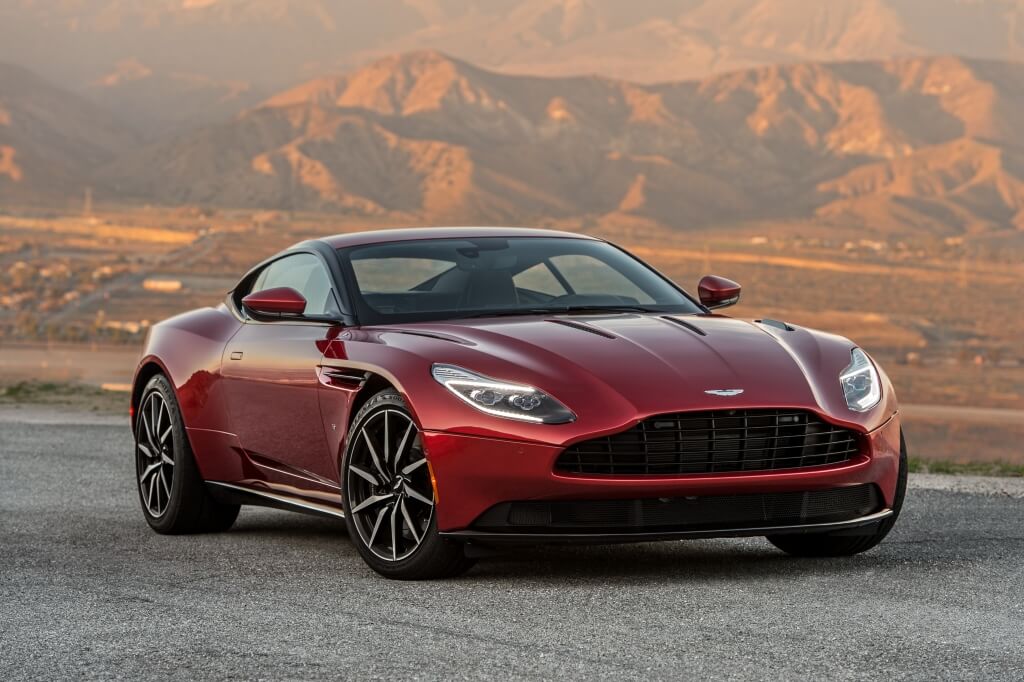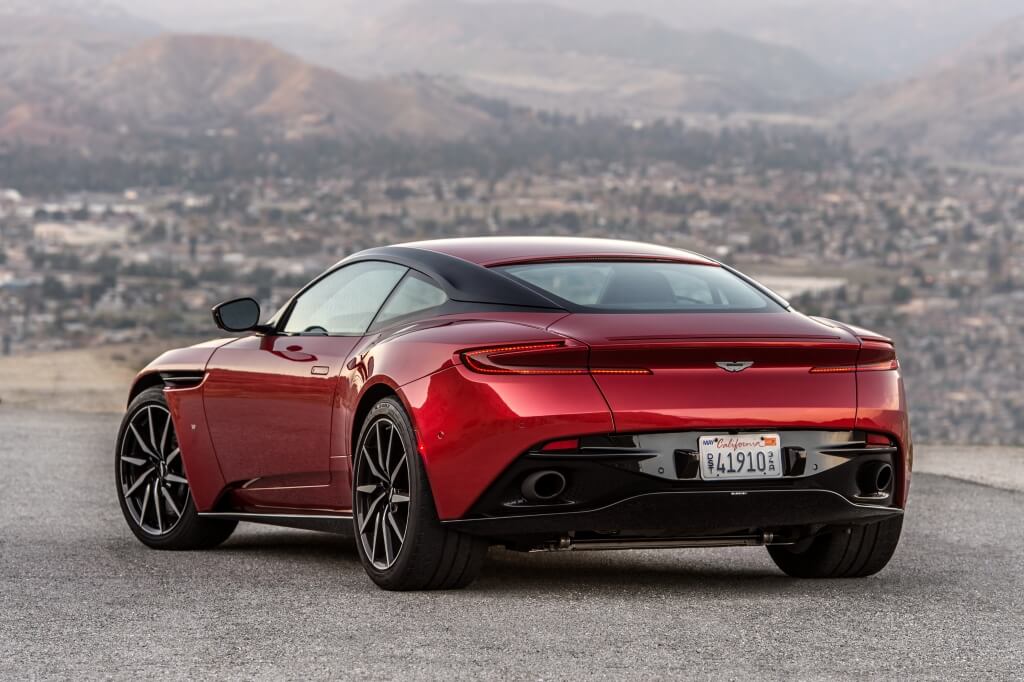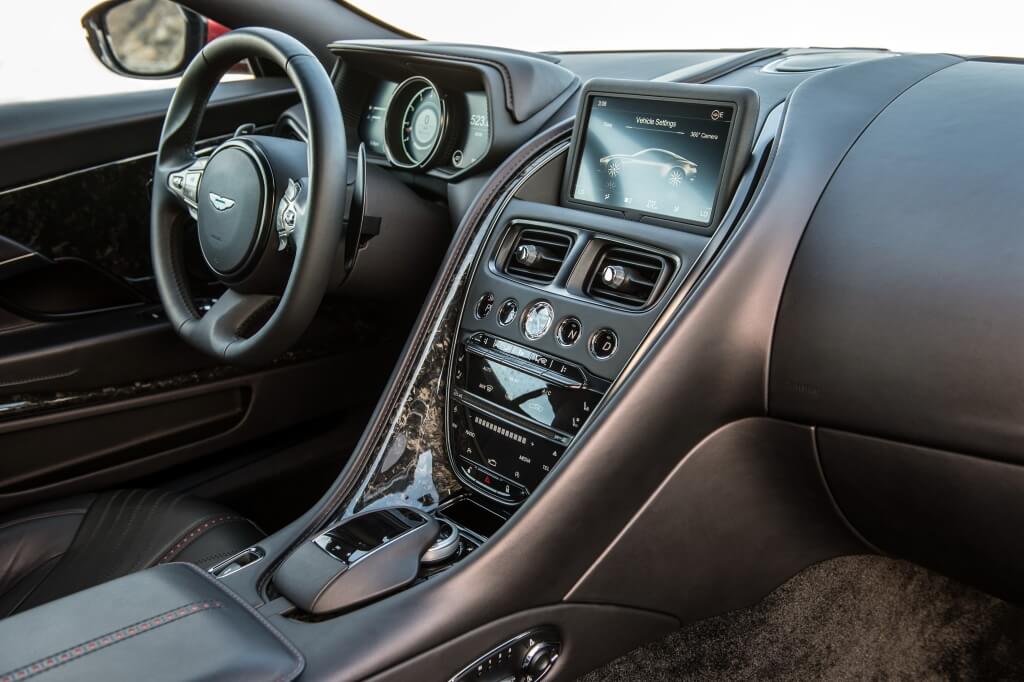Aston Martin DB11
Description
The Aston Martin DB11 is a sports car that replaced the DB9 model, produced from 2004 to 2016, and continued the iconic designation DB (David Brown's initials). Like all its predecessors, it was a luxury GT car, offering the customer the highest comfort and maximum performance.
Chronology
The DB11 was unveiled at the 86th Geneva Motor Show in 2016. Over 1,400 vehicles were ordered during the premiere. Production of the car officially began on September 28, 2016. In 2017, the Aston Martin DB11 won the Golden Steering Wheel Award for Most Beautiful Car of the Year. In 2018, the model was replaced by the Aston Martin DB11 AMR version.
Development
Aston Martin CEO Andy Palmer said: “We are committed to building the most beautiful cars in the world. The DB11 is the absolute epitome of what Aston Martin should be and we have worked tirelessly to ensure that the DB11 combines exceptional design with the latest technology throughout. An all-new aluminum platform, thoughtful aerodynamics, a distinctive new twin-turbocharged V12 engine and class-leading infotainment systems are just a few of the aspects that make this sports car proud to lead Aston Martin’s plan for a second century.”
The DB11 was designed by Marek Reichman, Aston Martin's creative designer. The use of the new engine made the model Aston Martin's first turbocharged production car.
Engine
Aston Martin's new in-house developed AE31 engine was fitted with twin turbocharging, making the DB11 the most powerful production DB model to date. With a working volume of 5.2 liters, it produced 608 hp. (600 bhp) at 6500 rpm and 700 Nm of torque from 1500 to 5000 rpm. The creators have abandoned the dry sump lubrication system, instead optimizing the wet sump design for high g-force operation. Also, the engine was equipped with conventional fuel injection rather than direct injection due to concerns about increased emissions, a start-stop system and a stainless steel exhaust system with catalytic conversion.
Transmission
Torque was sent to the rear wheels via an electronically controlled 8-speed ZF automatic transmission, a carbon fiber driveshaft and a self-locking differential.
Chassis
The DB11 was based on a new platform that replaced the old VH platform that debuted with the V12 Vanquish. The new platform was based on a light and rigid extruded aluminum space frame.
The suspension was completely new: double wishbones at the front and multi-links at the rear, on coil springs with anti-roll bars and adaptive dampers.
Adaptive Damping System (ADS) with Skyhook technology and 3 modes of operation: "GT", "Sport" and "Sport +" enhanced the response of the engine, 8-speed ZF automatic transmission along with electric power steering and changed the torque vectoring by braking while increasing the stiffness of the adaptive dampers.
20-inch aluminum wheels were shod with Bridgestone S007 tires 255/40 front and 295/35 rear.
Brake system
Standard equipment included 400mm ventilated disc brakes with 6-piston calipers at the front and 360mm with 4-piston calipers at the rear, ABS, EBD and EBA, Dynamic Stability Control (DSC), Traction Control, Torque Management (PTC) and its distribution between the rear wheels (DTV) and the shock absorption system (ADS).
Exterior
The appearance of the sports coupe is radically different from previous models: the exterior of the novelty featured features of the DB10 model, released in a limited edition of 10 copies specifically for the James Bond film Spectrum, as well as some design elements of the DBX and CC100 concepts.
The body of the Aston Martin DB11 has become wider and lower than that of its predecessor DB9. The hood was made in the form of a "clam" from a single piece of aluminum. The profile of the car was quite impressive thanks to the roof stripes that flowed continuously from the A-pillar to the C-pillar. The clean lines continued at the rear, with a sloping lid fading into boldly sculpted taillights. The car received full LED headlights.
Innovative aerodynamics played a part in this aesthetic revolution, with intelligent airflow management both above and through the bodywork contributing to stability. Front end lift was reduced with a gill curl that expelled high-pressure air from inside the wheel arch through a hidden vent in the redesigned side strip. Rear lift was reduced by the Aston Martin AeroBladeTM: a virtual spoiler powered by discreet air intakes located at the base of each C-pillar. The air passed through the body and then exited as a jet of air from an opening in the rear trunk lid.
Interior
The DB11 received wider doorways, significantly increased passenger space, especially head and legroom in the rear, fully integrated rear ISOFIX anchorage points for a pair of child seats, and ample luggage space for two large travel bags.
The cabin was equipped with a 12-inch digital instrument cluster LCD screen and another 8-inch console-mounted display for the infotainment system controlled via a Comand touch selector borrowed from Mercedes-Benz. For the first time, an Aston Martin also featured a parking assist system that showed a bird's-eye view of the car.
With a huge palette of colors and a wide range of finishes, the interior could satisfy any client request, from soothing, carefully chosen tones to stark contrasts in hues and textures. Nexus quilting and Celestial perforations added personality and beauty to the cabin.
Sources
Specification
| Bodywork | |
|---|---|
| Presentation | |
| Years of production |
2016-2018
|
| Produced (pcs.) |
4200
|
| Body type |
купе
|
| Number of doors |
2
|
| Number of places |
2+2
|
| Engine | |
|---|---|
| Engine type |
бензиновый
|
| Engine location |
спереди, продольное
|
| Engine model |
Aston Martin AE31 5.2 L Twin-turbocharged
|
| Cylinders |
V12
|
| V-angle |
60°
|
| Capacity (cc) |
5204
|
| Power output (hp / kW /) |
608 /
447 /
|
| at rpm |
6500
|
| Torque (N·m) |
7000
|
| at rpm |
1500-5000
|
| Bore (mm) |
89,0
|
| Stroke (mm) |
69,7
|
| Compression |
9,2
|
| Number of valves |
4/48
|
| Valvetrain |
DOHC
|
| Block material |
алюминиевый сплав
|
| Dry sump |
—
|
| Oil sump capacity (l) |
10,8
|
| Cooling volume (l) |
29,7
|
| Fuel system |
впрыск
|
| Turbocharger |
2
|
| Compressor model |
Mitsubishi
|
| Specific | |
|---|---|
| Specific output (hp/litre) |
116,83
|
| Specific output (hp/tonne) |
324,27
|
| Specific output (kg/hp) |
3,08
|
| Specific torque (N·m/litre) |
134,51
|
| Specific torque (N·m/tonne) |
373,30
|
| Transmission | |
|---|---|
| Driven wheels |
задний
|
| Gearbox model |
ZF 8HP75
|
| Gearbox |
автоматическая
|
| Number of speeds |
8
|
| Final drive ratio |
2,703
|
| First gear ratio |
4,714
|
| Second gear ratio |
3,143
|
| Third gear ratio |
2,106
|
| Fourth gear ratio |
1,667
|
| Fifth gear ratio |
1,285
|
| Sixth gear ratio |
1,000
|
| Seventh gear ratio |
0,839
|
| Eighth gear ratio |
0,667
|
| Reverse gear ratio |
3,317
|
| Suspension | |
|---|---|
| Front suspension |
независимая на двойных поперечных рычагах
|
| Rear suspension |
независимая многорычажная
|
| Elastic elements in front |
пружины
|
| Elastic elements in rear |
пружины
|
| Front anti-roll bar | |
| Rear anti-roll bar | |
| Wheel size front |
9J×20
|
| Wheel size rear |
11J×20
|
| Tire brand |
Bridgestone S007
|
| Tyres front |
255/40 R20
|
| Tyres rear |
295/35 R20
|
| Steering | |
|---|---|
| Steering type |
шестерня-рейка
|
| Power steering |
электрический
|
| Turning diameter (m) |
11,7
|
| Steering wheel turns |
2,4
|
| Brakes specs | |
|---|---|
| Brakes front |
дисковые вентилируемые
|
| Brakes rear |
дисковые вентилируемые
|
| Front brake diameter (mm) |
400×36
|
| Rear brake diameter (mm) |
360×32
|
| Disc material |
чугун
|
| Number of caliper pistons (front/rear) |
6/4
|
| Anti-lock braking system |
да
|
| Dimensions and weight | |
|---|---|
| Body |
несущий алюминиевый
|
| Body material |
алюминий
|
| Length (mm) |
4739
|
| Width (mm) |
1940
|
| Height (mm) |
1279
|
| Wheelbase (mm) |
2805
|
| Ground clearance (mm) |
122
|
| Approach angle (deg) |
10,9°
|
| Departure angle (deg) |
20,0°
|
| Drag coefficien |
0,360
|
| Dry weight (kg) |
1770
|
| Curb weight (kg) |
1875
|
| Trunk volume max (litre) |
270
|
| Weight distribution (%) |
51/49
|
| Performance specs | |
|---|---|
| Energy efficiency class |
G
|
| Ecological class |
Евро 6
|
| CO₂ emissions (NEDC) (g/km) |
265
|
| Fuel consumption (EC) highway (l/100 km) |
8,5
|
| Fuel consumption (EC) city (l/100 km) |
16,6
|
| Fuel consumption (EC) combined (l/100 km) |
11,4
|
| Fuel consumption (EPA) highway (l/100 km) |
11,2
|
| Fuel consumption (EPA) city (l/100 km) |
15,7
|
| Fuel consumption (NEDC) highway (l/100 km) |
8,5
|
| Fuel consumption (NEDC) city (l/100 km) |
16,6
|
| Fuel consumption (NEDC) combined (l/100 km) |
11,4
|
| Fuel tank capacity (l) |
78
|
| Fuel type |
Аи-98
|
| Dynamic specs | |
|---|---|
| Acceleration 0-10 kph (s) |
0,4
|
| Acceleration 0-20 kph (s) |
0,8
|
| Acceleration 0-30 kph (s) |
1,1
|
| Acceleration 0-40 kph (s) |
1,4
|
| Acceleration 0-50 kph (s) |
1,8
|
| Acceleration 0-60 kph (s) |
2,2
|
| Acceleration 0-70 kph (s) |
2,6
|
| Acceleration 0-80 kph (s) |
3,0
|
| Acceleration 0-90 kph (s) |
3,5
|
| Acceleration 0-100 kph (s) |
3,9
|
| Acceleration 0-110 kph (s) |
4,6
|
| Acceleration 0-120 kph (s) |
5,0
|
| Acceleration 0-130 kph (s) |
5,4
|
| Acceleration 0-140 kph (s) |
5,7
|
| Acceleration 0-150 kph (s) |
6,2
|
| Acceleration 0-160 kph (s) |
6,8
|
| Acceleration 0-170 kph (s) |
7,7
|
| Acceleration 0-180 kph (s) |
8,8
|
| Acceleration 0-190 kph (s) |
10,3
|
| Acceleration 0-200 kph (s) |
12,3
|
| Acceleration 0-210 kph (s) |
15,0
|
| Acceleration 0-220 kph (s) |
18,4
|
| Acceleration 0-230 kph (s) |
22,3
|
| Acceleration 0-240 kph (s) |
26,6
|
| Acceleration 0-250 kph (s) |
31,0
|
| Acceleration 0-260 kph (s) |
35,4
|
| Acceleration 0-270 kph (s) |
39,5
|
| Acceleration 0-280 kph (s) |
43,3
|
| Acceleration 0-290 kph (s) |
46,4
|
| Acceleration 0-300 kph (s) |
48,7
|
| Acceleration 0-10 mph (s) |
0,6
|
|---|---|
| Acceleration 0-20 mph (s) |
1,2
|
| Acceleration 0-30 mph (s) |
1,7
|
| Acceleration 0-40 mph (s) |
2,3
|
| Acceleration 0-50 mph (s) |
3,0
|
| Acceleration 0-60 mph (s) |
3,7
|
| Acceleration 0-70 mph (s) |
4,7
|
| Acceleration 0-80 mph (s) |
5,3
|
| Acceleration 0-90 mph (s) |
5,9
|
| Acceleration 0-100 mph (s) |
6,9
|
| Acceleration 0-110 mph (s) |
8,4
|
| Acceleration 0-120 mph (s) |
10,9
|
| Acceleration 0-130 mph (s) |
14,7
|
| Acceleration 0-140 mph (s) |
20,4
|
| Acceleration 0-150 mph (s) |
27,2
|
| Acceleration 0-160 mph (s) |
34,3
|
| Acceleration 0-170 mph (s) |
40,9
|
| Acceleration 0-180 mph (s) |
46,3
|
| Acceleration 0-92 m (300 feet) (s) /kph/ |
5,3 /
121,0 /
|
|---|---|
| Acceleration 0-100 m (s) /kph/ |
5,6 /
125,0 /
|
| Acceleration 0-200 m (s) /kph/ |
8,3 /
162,0 /
|
| Acceleration 0-201 m (1/8 mile) (s) /kph/ |
8,4 /
163,0 /
|
| Acceleration 0-300 m (s) /kph/ |
10,4 /
184,0 /
|
| Acceleration 0-305 m (1000 feet) (s) /kph/ |
10,5 /
185,0 /
|
| Acceleration 0-400 m (s) /kph/ |
12,3 /
200,0 /
|
| Acceleration 0-402 m (1/4 mile) (s) /kph/ |
12,3 /
200,0 /
|
| Acceleration 0-500 m (s) /kph/ |
14,1 /
212,0 /
|
| Acceleration 0-600 m (s) /kph/ |
15,9 /
224,0 /
|
| Acceleration 0-610 m (2000 feet) (s) /kph/ |
16,0 /
225,0 /
|
| Acceleration 0-700 m (s) /kph/ |
17,6 /
234,0 /
|
| Acceleration 0-800 m (s) /kph/ |
19,3 /
242,0 /
|
| Acceleration 0-805 m (1/2 mile) (s) /kph/ |
19,4 /
243,0 /
|
| Acceleration 0-900 m (s) /kph/ |
21,0 /
250,0 /
|
| Acceleration 0-914 m (3000 feet) (s) /kph/ |
21,3 /
251,0 /
|
| Acceleration 0-1000 m (s) /kph/ |
22,7 /
256,0 /
|
| Acceleration 0-1067 m (3500 feet) (s) /kph/ |
23,8 /
261,0 /
|
| Acceleration 0-1100 m (s) /kph/ |
24,3 /
262,0 /
|
| Acceleration 0-1200 m (s) /kph/ |
25,9 /
267,0 /
|
| Acceleration 0-1219 m (4000 feet) (s) /kph/ |
26,2 /
267,0 /
|
| Acceleration 0-1300 m (s) /kph/ |
27,4 /
271,0 /
|
| Acceleration 0-1400 m (s) /kph/ |
28,9 /
274,0 /
|
| Acceleration 0-1500 m (s) /kph/ |
30,3 /
277,0 /
|
| Acceleration 0-1610 m (1 mile) (s) /kph/ |
31,9 /
280,0 /
|
| Rolling acceleration 60-100 kph (s) |
3,1 (4)
|
|---|---|
| Rolling acceleration 60-100 kph (s) |
4,2 (5)
|
| Rolling acceleration 60-120 kph (s) |
3,1 (4)
|
| Rolling acceleration 60-120 kph (s) |
4,2 (5)
|
| Rolling acceleration 80-120 kph (s) |
3,3 (4)
|
| Rolling acceleration 80-120 kph (s) |
4,1 (5)
|
| Rolling acceleration 80-120 kph (s) |
5,4 (6)
|
| Rolling acceleration 80-120 kph (s) |
7,2 (7)
|
| Rolling acceleration 80-120 kph (s) |
11,3 (8)
|
| Rolling acceleration 80-160 kph (s) |
6,8 (4)
|
| Rolling acceleration 80-160 kph (s) |
9,0 (5)
|
| Rolling acceleration 80-160 kph (s) |
11,5 (6)
|
| Rolling acceleration 80-160 kph (s) |
15,4 (7)
|
| Rolling acceleration 80-160 kph (s) |
23,4 (8)
|
| Rolling acceleration 100-140 kph (s) |
2,9
|
| Rolling acceleration 100-200 kph (s) |
8,2
|
| Est. 0 – 100 mph – 0 (s) |
11,8
|
| Braking distance 100-0 kph (m) |
33
|
| Braking distance 130-0 kph (m) |
58
|
| Braking distance 190-0 kph (m) |
124
|
| Braking distance 200-0 kph (m) |
137
|
| Braking distance 60-0 mph (m) |
32
|
| Braking distance 70-0 mph (m) |
48
|
| Top speed (kph) |
322
|
|---|---|
| Top speed (mph) |
200
|
| Tags: | |
|---|---|
| Type: | |
| Brand: | |
| Country: |



